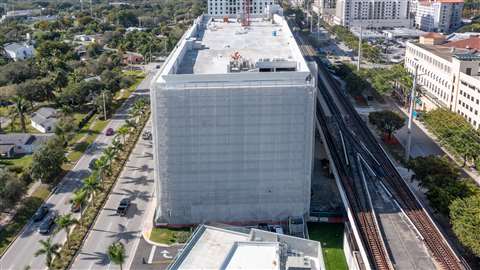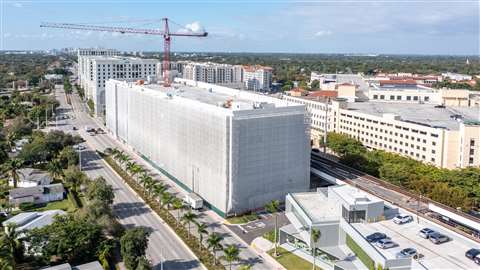Project wrap: 16 stories of scaffolding
August 02, 2022
East Coast Rigging & Scaffolding of Florida, a division of East Coast Rigging & Contracting Company, recently facilitated work on a new multi-story Jaguar Land Rover facility in Coral Gables utilizing Layher scaffolding. The ambitious project called for a full scaffolding wrap of the 7-story showroom, necessitating 16 levels of scaffolding construction to provide multiple trades with access to the façade.
Site work began in January of 2021, with General Contractor – Burke Construction Group – bringing in ECRS-FL in July 2021 to provide safe vertical access approaches to support the façade finishes required.
 Limited staging on either side of the building made logistics a key project component. (Photo: Layher)
Limited staging on either side of the building made logistics a key project component. (Photo: Layher)
Traditional scaffold vs. swing stages
Burke initially explored swing stages (also known as suspended scaffolding) as a potential solution before settling on a full building wrap using multi-level fixed scaffolding with input from ECRS-FL. The swing stage approach was initially attractive to Burke and the Project Owners’ Representatives due to their reduced price and minimal footprint, but there are notable drawbacks.
Safety
The first consideration is always safety. Because the new dealership is located adjacent to the busy U.S. 1 Highway, containment of debris and material was of the utmost concern. Full system scaffolding is more readily contained, better shielding commuters and pedestrians from material excesses that may be carried by the wind. Complete containment utilizing swing stages is also extremely difficult to achieve. In the end, the risk was not a viable option for liability concerns.
Productivity
The next concern is productivity. Suspended scaffolding allows access to one level at a time, which means only one trade can work. When five different trades need access, including waterproofing, stucco, and window subcontractors, this adds up to a significant time investment that traditional scaffolding avoids.
 East Coast Rigging & Scaffolding’s wrap of the multi-story Jaguar Land Rover facility in Coral Gables, FL. (Photo: Layher)
East Coast Rigging & Scaffolding’s wrap of the multi-story Jaguar Land Rover facility in Coral Gables, FL. (Photo: Layher)
“When you have an opportunity to put 15 men on a wall as opposed to four, you can do the math yourself and see how productive you’re going to be,” says ECRS-FL General Manager Joel Ross, who estimates productivity was multiplied up to four times with Layher system scaffolding.
Ross proposed a full wrap to allow different trades to work on multiple levels simultaneously with a mesh netting for full containment of material or debris, winning over the GC with an argument for increased productivity.
“The longer you take, the more money you ultimately spend,” says Ross “Scaffolding minimizes the potential for delays.”
Ultimately, the project was executed in phases over a four-month period to make the most of trade availability.
The design
ECRS-FL contracted independent engineer Norman Brown, III for design, as attachments to the building required strategic placement to allow seamless application of finishes. Luis Garcia, a project manager with ECRS-FL, incorporated subsequent changes to account for onsite realities. The final design called for over 33,000 Layher, USA components, including four sets of temporary stair towers.
Logistics
A reduced site footprint with limited staging made logistics a key project consideration. Ross noted a mere 10 feet to the fence line on the side facing the street and a light rail on the other side where train regulations are strict. With the site operation managed by Miguel Devia, Field Superintendent, ECRS-FL met and exceeded all logistical expectations.
 A full scaffolding wrap facilitated access to the façade by multiple trades at the same time. (Photo: Layher)
A full scaffolding wrap facilitated access to the façade by multiple trades at the same time. (Photo: Layher)
Layher, USA Regional Sales Manager Obed Bosch was critical in materials and workflow coordination to accommodate needs, arranging for a total of 20 truckloads to arrive from Layher, USA’s supply yard in Ocala, FL to supplement what ECRS-FL had on hand. “Layher, USA customers benefit from reduced freight rates and fast response times that comes with strategic branch placement,” says Bosch.
A crew of 14 ultimately staged and assembled the scaffolding in multiple 10-hour shifts per project phase. Upon completion of the scaffolding, approximately 123,000 square feet of white debris containment netting, provided by Eagle Industries, kept debris and materials contained while protecting workers with relief from the Florida sun.
The project is currently in the final stages with dismantling completed in late May.
STAY CONNECTED



Receive the information you need when you need it through our world-leading magazines, newsletters and daily briefings.
CONNECT WITH THE TEAM







